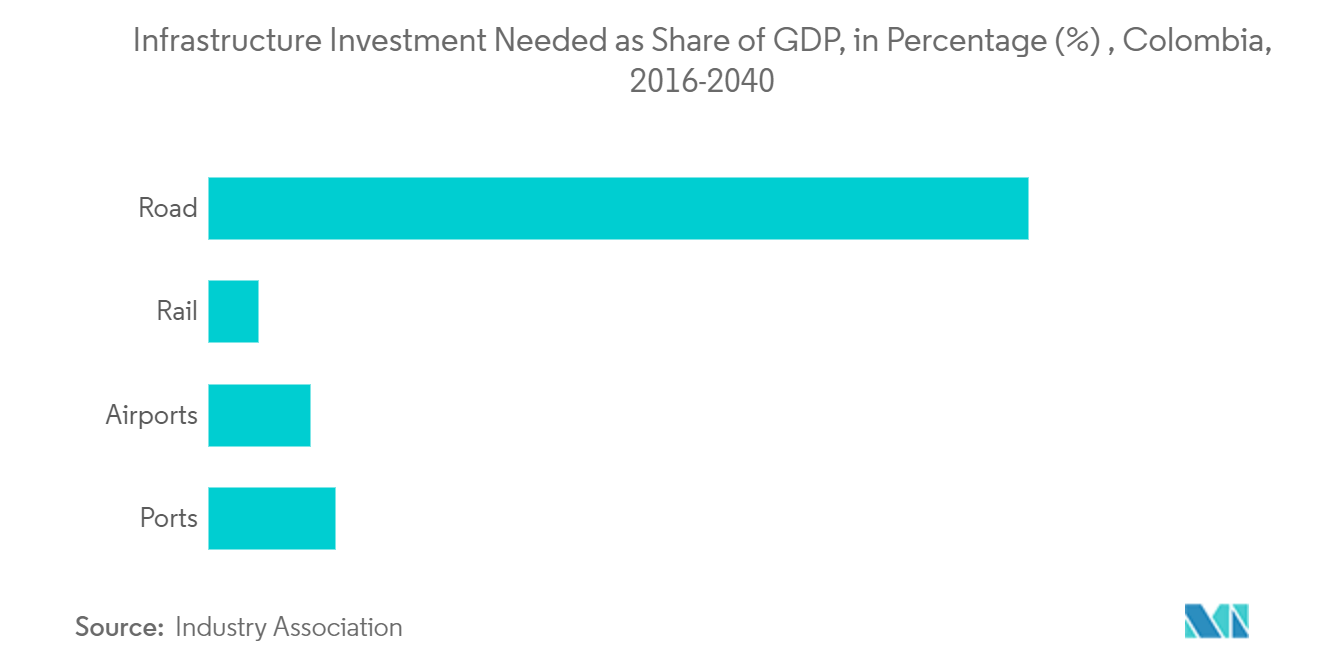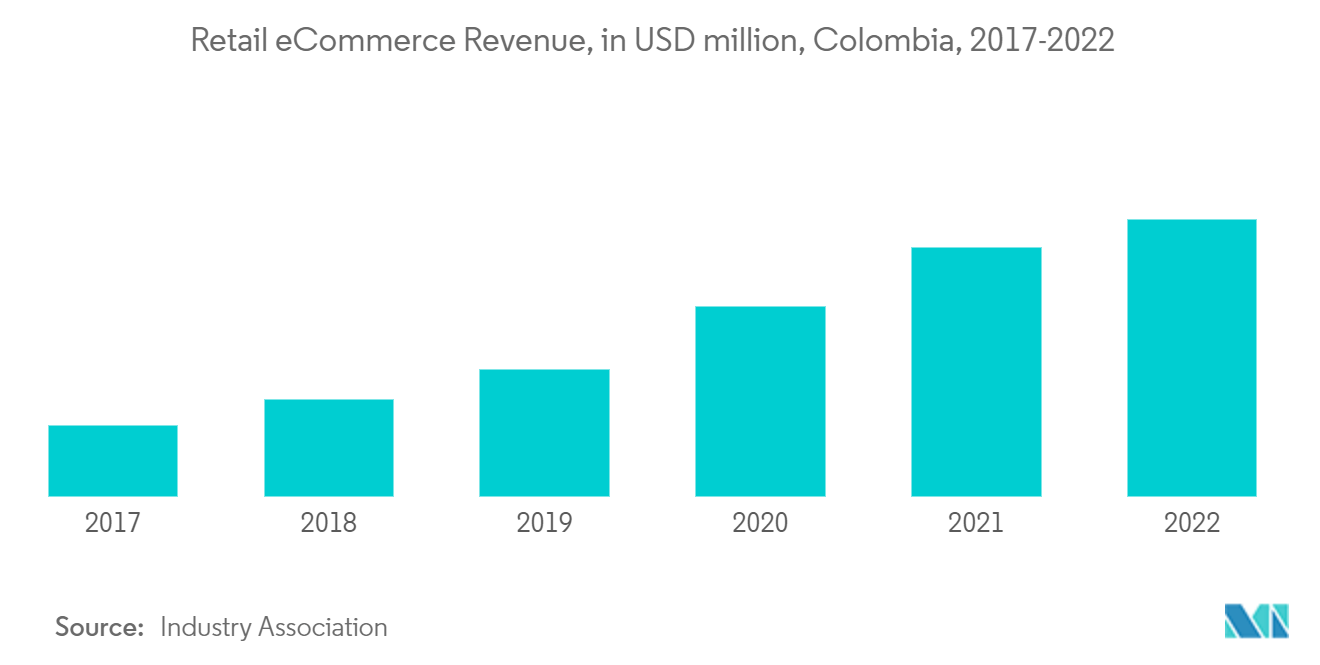Market Trends of Colombia Third-party Logistics (3PL) Industry
This section covers the major market trends shaping the Colombia 3PL Market according to our research experts:
Colombia Third-party Logistics (3PL) Market Trends
After the signing of the Peace Agreement between the Colombian Government and the Revolutionary Armed Forces of Colombia (FARC) in 2016, infrastructure development became a priority for Colombia. In 2015, the Santos Administration established an infrastructure initiative to connect Colombia through multimodal transportation projects, commonly referred to as the Intermodal Transportation Master Plan (PMTI). This initiative encompasses 101 road projects, 52 highway projects, 5 railway projects, 8 fluvial projects, 31 airport projects, and various dredging projects. In 2016, the value established for this ambitious initiative was COP 10.4 trillion (USD 2.7 billion) equivalent to 1.3% of Colombia's GDP. The Plan is divided into two major programs named fourth-generation infrastructure projects (4G) and fifth-generation infrastructure projects (5G). 4G Infrastructure projects aim to develop the country's connectivity and promote economic development by connecting industrial regions with the port's areas. They encompass 29 road projects to construct 4,970 miles of dual carriageways, repair 4.349 miles of roads, and construct 141 tunnels and 1,300 viaducts. Prior to August 2022, 20 projects were completed and the remaining 9 will be developed. According to the Colombian Transportation Ministry, these highway projects are valued at COP 47 billion (USD 12 million).
The mentioned 5G Infrastructure initiative included seven road projects, four airport projects, two river projects, and one railway project. By May 2022, three 5G road Infrastructure projects have been awarded including Valle del Cauca Road, ALO sur, and Accesos Norte II, while four projects are in the tender process, including the second most important river project in Colombia, the Canal del Dique PPP. Colombia's 2021 transportation budget was COP 12 trillion (USD 3.1 billion). According to Colombia's Infrastructure Chamber of Commerce, this budget may increase to COP 15 trillion (USD 3.9 billion) in 2023. In November 2020, the Railway Master Plan for Colombia was launched. It aimed to improve and develop cargo and passenger railway lines. The Plan set a goal to reduce 26% of the country's logistics costs to improve productivity and reduce environmental pollution. The greater Bogota and Medellin areas plan to have railway developments in the coming years. Bogota aims to foster the Cundinamarca region by connecting the city and rural surrounding areas with metro lines and commuter trains. Cartagena's new airport initiative is currently under the feasibility stage, once National Infrastructure Agency (ANI) approves it, the project will be developed. It will have the capability for 8 million passengers per year and will manage 35 flight operations per hour. This continuous transportation infrastructure investment in Colombia will support the 3PL market growth in the coming years.

eCommerce Driving the Growth of the Market
The eCommerce world has soared in 2021 and 2022 due to the confinement that the whole planet had to endure due to the arrival of COVID-19. In Latin America, there was also a significant advance in the technological world, with Colombia being one of the countries that decided to adopt these practices. Colombia ranked fourth in 2020 as the largest e-commerce market in Latin America in online sales revenue, after Brazil, Mexico, and Argentina. According to the Colombian Chamber of Electronic Commerce (CCCE), Colombian eCommerce reached sales worth 10,000 million dollars in 2021, representing a growth of 40.2% compared to 2020. Factors driving growth, particularly in the B2C segment, include greater accessibility to web services through smartphones and increased online services, especially banking and online payment services. Business to Business (B2B) eCommerce in Colombia is becoming more common. Linio, Mercado Libre, and Dafiti, are the strongest players in e-commerce in the Colombian market. The Colombian Chamber of Electronic Commerce (CCCE) expects that in 2022 Colombian eCommerce increased by 15% compared to 2021. Thus, during the first quarter of 2022, total online sales in Colombia equivalent to 3,000 million dollars were reached.
The eCommerce growth in Colombia is also driven by government support. In December 2020, the National Council for Economic and Social Policy (CONPES) approved the National Policy for Electronic Commerce. This strategy seeks to promote eCommerce in companies and the general public to increase social and economic value generation. According to estimates by an industry association, the e-commerce market in Colombia could increase in the coming years, showing a growth rate of 11% considering that at least 40% of the Colombian population has made at least one purchase online.With this tremendous growth of eCommerce in Colombia, the demand for 3PL services in the market will also increase. There are already many 3PL providers operating in the market. According to a study, Coordinadora is considered the main provider of delivery services for Colombia's eCommerce. In fact, 29% of the digital stores consulted said that Coordinadora is their shipping management provider; they are followed by Servientrega with 23% and Envía with 10%. Only Coordinadora has a reach of over 1,200 national destinations as well as international shipping. In the case of Servientrega, it is a company that has managed to expand not only throughout Latin America but also to the United States; while Envía focuses more on national territory with a reach of 1,013 municipalities and 386 populated centers.


